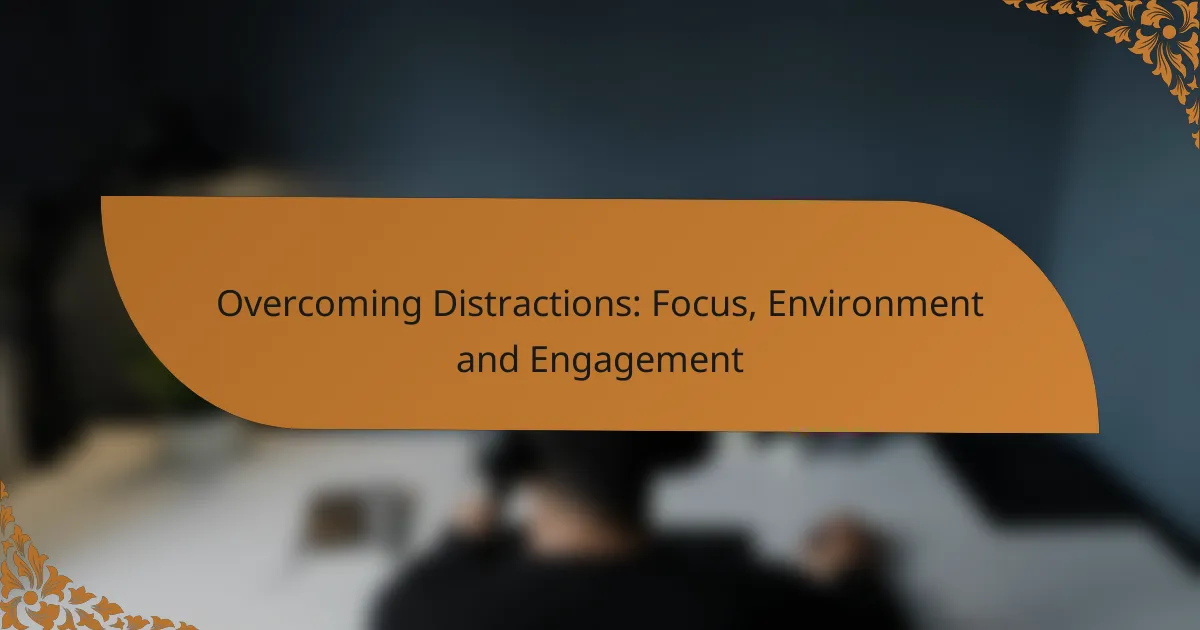Overcoming distractions is essential for enhancing focus and productivity in today’s fast-paced world. By managing your environment and employing effective engagement techniques, you can create a workspace that minimizes interruptions and fosters concentration. Utilizing methods like the Pomodoro Technique and incorporating elements that promote active involvement can significantly improve your ability to stay focused on tasks.
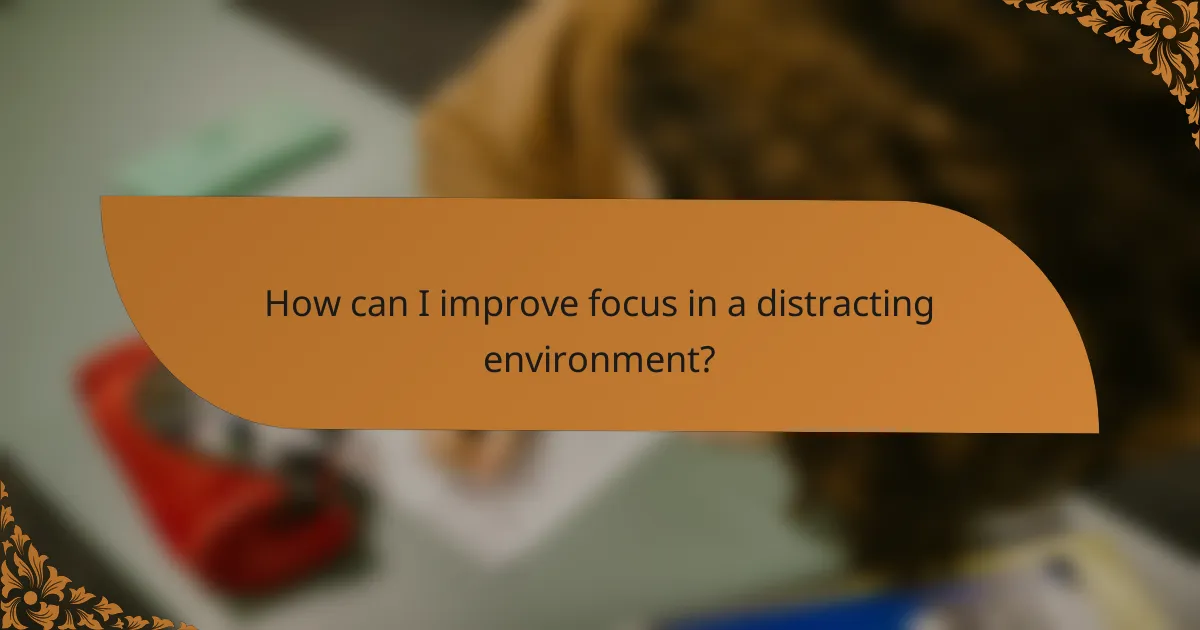
How can I improve focus in a distracting environment?
Improving focus in a distracting environment involves actively managing your surroundings and habits. By minimizing interruptions, creating a specific workspace, and employing techniques like the Pomodoro Technique, you can enhance your concentration and productivity.
Minimize digital distractions
Digital distractions can significantly hinder your focus. Start by turning off non-essential notifications on your devices and using apps that block distracting websites during work hours. Consider setting specific times to check emails and social media, rather than allowing them to interrupt your workflow.
Another effective strategy is to keep your phone out of reach or in another room while working. This simple act can reduce the temptation to check messages or notifications, allowing you to concentrate better on your tasks.
Create a dedicated workspace
A dedicated workspace helps signal to your brain that it’s time to focus. Choose a specific area in your home or office that is free from distractions and clutter. Make sure this space is equipped with everything you need to work efficiently, such as a comfortable chair, proper lighting, and necessary tools.
Personalize your workspace with elements that inspire you, but avoid excessive decorations that could divert your attention. Establishing a routine around this space can also reinforce your focus, making it easier to enter a productive mindset.
Use noise-canceling headphones
Noise-canceling headphones can create a quieter environment, helping you to concentrate better. They work by blocking out ambient sounds, allowing you to focus on your tasks without distractions from your surroundings. Consider using them in busy offices or public spaces where noise levels can be high.
Listening to instrumental music or white noise through these headphones can further enhance your focus. Experiment with different sounds to find what works best for you, as some people may prefer nature sounds while others might find classical music more effective.
Implement the Pomodoro Technique
The Pomodoro Technique is a time management method that can boost focus by breaking work into intervals, typically 25 minutes long, followed by short breaks. This structured approach helps maintain concentration and prevents burnout by ensuring regular rest periods.
To implement this technique, set a timer for 25 minutes and work on a single task until the timer goes off. Afterward, take a 5-minute break to recharge. After completing four cycles, take a longer break of 15-30 minutes. This method encourages sustained focus while allowing for necessary downtime.
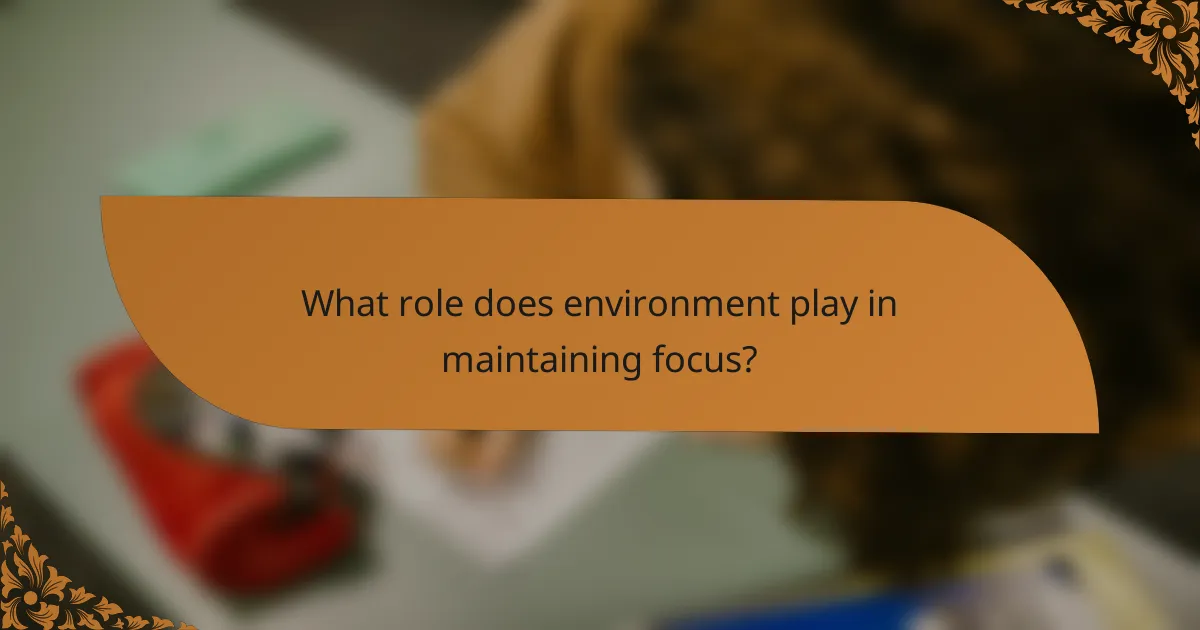
What role does environment play in maintaining focus?
The environment significantly influences an individual’s ability to maintain focus. Factors such as lighting, ergonomics, and the presence of natural elements can enhance concentration and productivity while minimizing distractions.
Importance of lighting and ergonomics
Proper lighting and ergonomic setups are crucial for sustaining focus. Natural light is preferable as it reduces eye strain and boosts mood, while adjustable artificial lighting can help create a comfortable workspace. Ergonomics, including chair height and desk setup, should promote good posture to prevent discomfort that can lead to distractions.
Consider using task lighting for specific areas and ensuring that your monitor is at eye level to minimize strain. Aim for a workspace that allows for movement and adjustments to maintain comfort throughout the day.
Impact of clutter on productivity
Clutter can significantly hinder productivity by creating visual distractions and mental overload. A disorganized workspace can lead to wasted time spent searching for items and increased stress levels, which detracts from focus.
To combat clutter, establish a regular cleaning routine and implement organizational systems such as trays or digital tools for document management. Aim for a minimalist approach, keeping only essential items within reach to foster a clearer mind.
Benefits of natural elements in workspace
Incorporating natural elements into your workspace can enhance focus and overall well-being. Plants, for example, not only improve air quality but also promote a sense of calm and reduce stress, which can lead to better concentration.
Consider adding greenery, such as small potted plants or succulents, to your desk. Additionally, using natural materials in your workspace design, like wood or stone, can create a more inviting and less distracting environment, further supporting sustained attention.
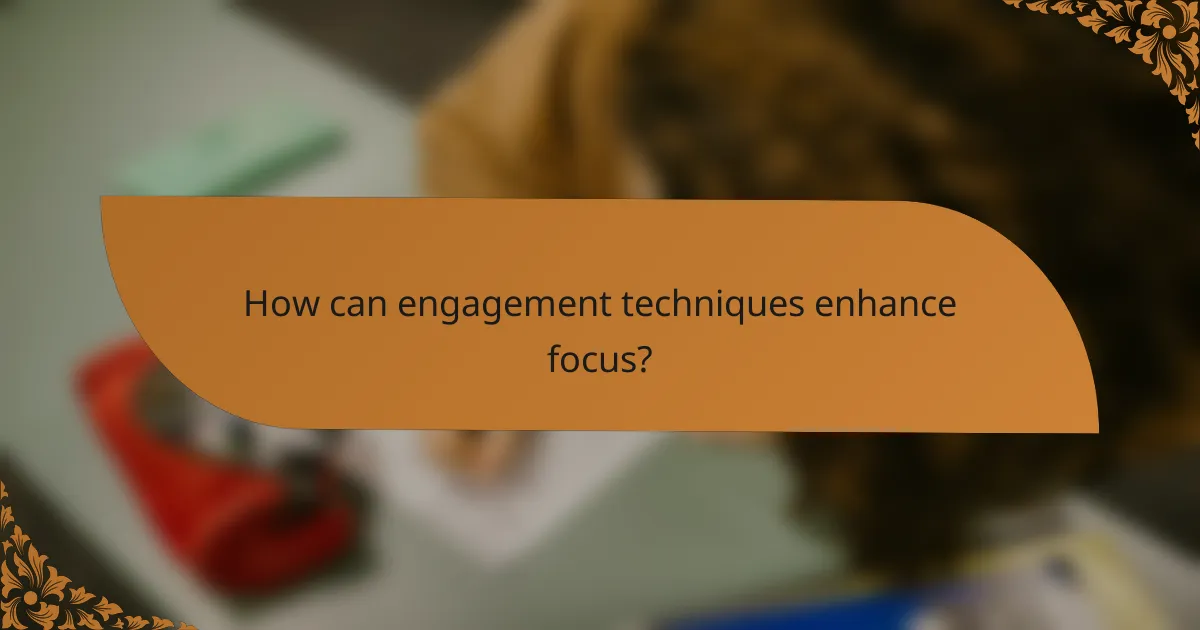
How can engagement techniques enhance focus?
Engagement techniques can significantly enhance focus by actively involving individuals in their tasks, making them more invested and attentive. By incorporating methods such as active learning, gamification, and collaborative work, distractions can be minimized, leading to improved concentration and productivity.
Active learning strategies
Active learning strategies involve engaging with material through discussion, practice, and application rather than passive consumption. Techniques such as summarizing information, teaching others, or applying concepts to real-world scenarios can deepen understanding and retention.
To implement active learning, consider using methods like group discussions or hands-on projects. These approaches encourage participation and can make learning more enjoyable, which in turn boosts focus.
Gamification of tasks
Gamification involves applying game-like elements to non-game contexts to enhance motivation and engagement. By introducing rewards, challenges, and competition, tasks can become more appealing, encouraging sustained attention and effort.
For instance, using point systems or badges for completing tasks can create a sense of achievement. This method is particularly effective in educational settings and workplaces, where it can transform mundane tasks into exciting challenges.
Collaborative work sessions
Collaborative work sessions foster teamwork and shared responsibility, which can enhance focus through mutual support and accountability. Working alongside others can help maintain motivation and provide diverse perspectives on problem-solving.
To maximize the benefits of collaboration, establish clear goals and roles for each participant. Regular check-ins can also help keep everyone on track and engaged, reducing the likelihood of distractions during the session.
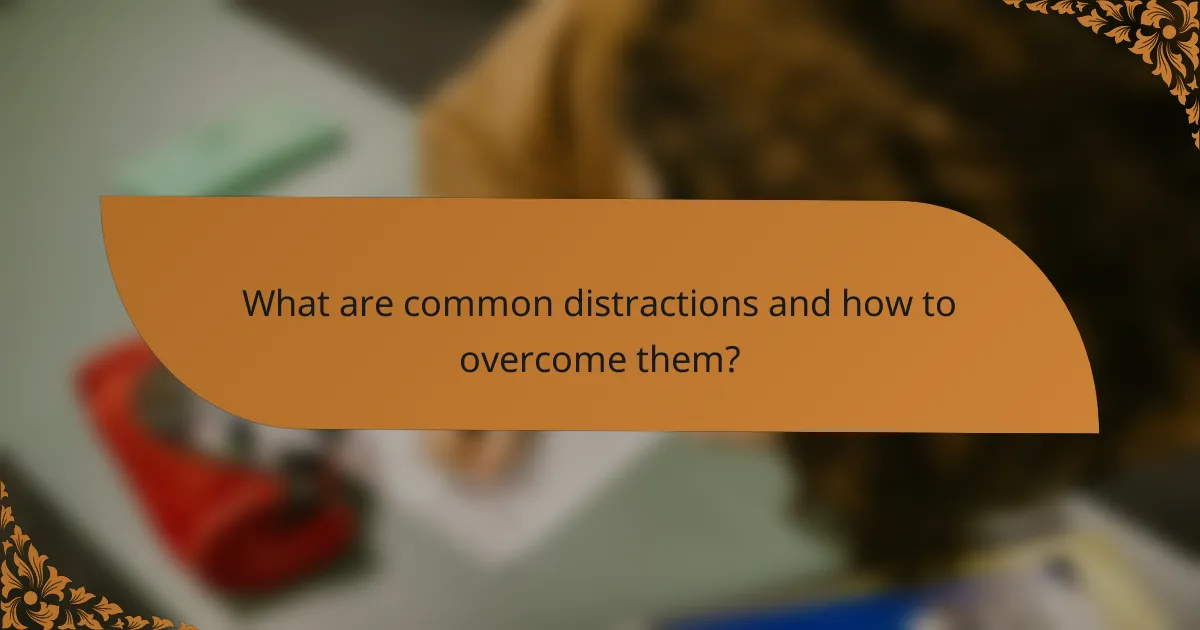
What are common distractions and how to overcome them?
Common distractions include social media, interruptions from colleagues, and a cluttered workspace. To overcome these distractions, implement strategies such as using management tools, time-blocking, and setting clear boundaries with coworkers.
Social media management tools
Social media management tools help streamline your online presence and reduce distractions by scheduling posts and monitoring engagement. Tools like Hootsuite or Buffer allow you to plan content in advance, freeing up time for focused work.
When using these tools, consider setting specific times to check your social media accounts. This can prevent constant notifications from interrupting your workflow. Aim to limit social media checks to a few times a day rather than continuously throughout your work hours.
Time-blocking techniques
Time-blocking involves dividing your day into specific segments dedicated to particular tasks, minimizing distractions. For instance, allocate 90-minute blocks for focused work followed by short breaks to recharge.
To implement time-blocking effectively, use a digital calendar or planner to visualize your schedule. Be realistic about how much time each task will take, and avoid overloading your blocks to maintain productivity without burnout.
Setting boundaries with colleagues
Setting boundaries with colleagues is essential for maintaining focus and minimizing interruptions. Communicate your availability clearly, such as using “do not disturb” signals during deep work periods.
Consider establishing specific times for collaborative discussions or meetings, allowing uninterrupted work time. Encourage colleagues to respect these boundaries, fostering a culture of focus and productivity within your team.

How do personal habits affect focus?
Personal habits significantly influence focus by shaping our mental and physical states. Good habits, such as maintaining a consistent sleep schedule and engaging in regular exercise, can enhance concentration, while poor habits often lead to distractions and decreased productivity.
Sleep hygiene practices
Sleep hygiene refers to the habits and practices that promote consistent, quality sleep. Establishing a regular sleep schedule, creating a comfortable sleep environment, and limiting screen time before bed are essential steps to improve sleep quality. Aim for 7-9 hours of sleep per night to support optimal focus during the day.
Common pitfalls include consuming caffeine or heavy meals close to bedtime, which can disrupt sleep patterns. Consider implementing a relaxing bedtime routine to signal your body that it’s time to wind down.
Mindfulness and meditation
Mindfulness and meditation can significantly enhance focus by training the mind to remain present and attentive. Practicing mindfulness for just a few minutes each day can help reduce stress and improve cognitive function. Techniques such as deep breathing or guided meditation can be effective starting points.
To incorporate mindfulness into your routine, try setting aside 5-10 minutes daily for focused breathing or meditation. Avoid distractions during this time to maximize the benefits.
Regular physical activity
Engaging in regular physical activity is crucial for maintaining focus and mental clarity. Exercise increases blood flow to the brain, which can enhance cognitive function and reduce feelings of fatigue. Aim for at least 150 minutes of moderate aerobic activity each week, such as brisk walking or cycling.
Incorporating short bursts of activity throughout the day, like a quick walk or stretching, can also help refresh your mind and improve concentration. Be mindful of your body’s signals and adjust your activity level to maintain energy without overexertion.
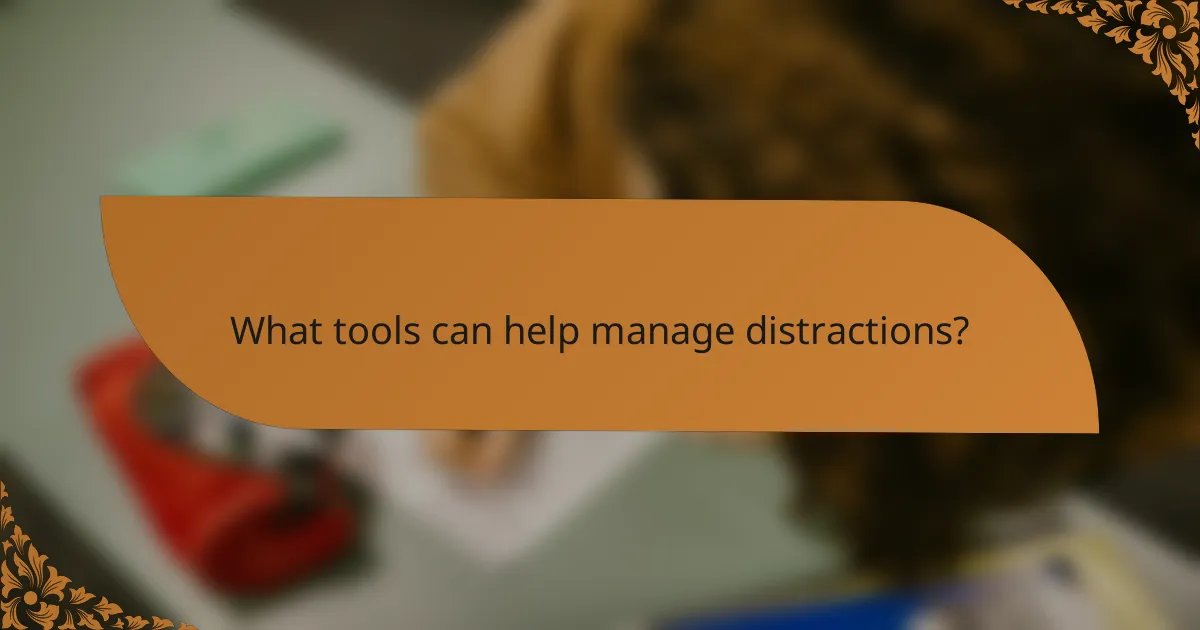
What tools can help manage distractions?
Several tools can effectively help manage distractions, enhancing focus and productivity. These tools range from music services to apps designed to limit interruptions and create a conducive work environment.
Focus@Will music service
Focus@Will is a music service specifically designed to improve concentration and reduce distractions. It offers a variety of instrumental music channels that are scientifically optimized to enhance focus and productivity.
When using Focus@Will, users can select from different genres tailored to their personal preferences and work styles. The platform employs a unique algorithm that adjusts the music based on user feedback and engagement levels, making it a personalized experience.
To maximize its effectiveness, consider using Focus@Will during tasks that require deep concentration, such as writing or coding. Avoid using it for activities that require verbal processing, like reading or participating in meetings, as the music may interfere with comprehension.
